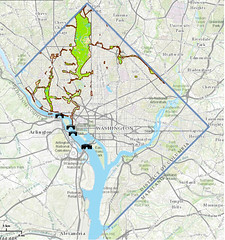At a Glance
Learn More
Rock Creek Park is a peaceful and beautiful refuge within a bustling city. Because of its location in the midst of our nation’s capital, the park has a rich cultural history. It also boasts a rich natural history. With great variation in the landscape, Rock Creek Park has a wide diversity of habitats in which natural communities can flourish.
Explore Rock Creek Park’s natural communities!
The landscape in Rock Creek Park includes a variety of captivating natural features—
- a winding, rocky creek in the bottom of a steep valley with a stretch of rapids;
- patches of flat, fertile floodplains with infrequent seasonal pools and groundwater seeps;
- valley walls that rise dramatically with jagged rock outcrops to high ridges and bluffs;
- moist, fern-laden ravines;
- rolling hillsides cloaked with American beech;
- cobblestone-sprinkled dry hilltops dense with oak trees and mountain laurel.
Reading the Landscape
No story about any one feature at Rock Creek Park—whether plant or animal, bedrock, shape of the land, stream, or historic/current land use—is complete without understanding something about how each impacts all the others.
Let this website help weave together some of these stories and develop your ability to "read the landscape" at Rock Creek Park the way a skilled naturalist can read animal tracks. Explore the website and learn how plants and animals interact with each other and the physical setting to form recognizable natural communities.
Learn how humans have influenced those natural communities in the past, and continue to do so today—check out Water & Land Use in the Stewardship and Ecological Threats section.
Then... use the interactive map of Rock Creek Park to plan a visit. Armed with your newfound knowledge and skills, hit the trails and explore the natural communities of Rock Creek Park!
How the Park Came To Be
Rock Creek Park is the oldest and largest urban national park in the United States. Recognized in the early days of Washington, D.C., as a remarkable, peaceful retreat for residents and visitors to the nation’s capital, the area was established as a national park by Congress in 1890 for the preservation “of all timber, animals or curiosities … and their retention in the natural condition, as nearly as possible.”1 Its core 1,754 acres consisted of a roughly six-mile stretch of Rock Creek with its accompanying valleys and ridges as it flows from the Maryland state line south to the Smithsonian's National Zoological Park (the National Zoo), along with two of its major tributaries and their valleys—Broad Branch and Piney Branch.2 3
 Rock Creek Park administers 2,800 acres in Washington, D.C.In the years that followed, more natural areas were added to the park, including Rock Creek south of the National Zoo, other tributaries of Rock Creek, and other forested parks farther west. Historic and cultural areas, such as the Fort Circle Parks and other sites of Civil War defenses, were also added. Altogether there are now 99 distinct areas (and over 2,800 acres) that Rock Creek Park administers—nearly 7% of the District of Columbia. Even those parcels that bear unique names (such as Glover Archbold Park, Battery Kemble Park, and Dumbarton Oaks Park) are included in the interactive map of Rock Creek Park.
Rock Creek Park administers 2,800 acres in Washington, D.C.In the years that followed, more natural areas were added to the park, including Rock Creek south of the National Zoo, other tributaries of Rock Creek, and other forested parks farther west. Historic and cultural areas, such as the Fort Circle Parks and other sites of Civil War defenses, were also added. Altogether there are now 99 distinct areas (and over 2,800 acres) that Rock Creek Park administers—nearly 7% of the District of Columbia. Even those parcels that bear unique names (such as Glover Archbold Park, Battery Kemble Park, and Dumbarton Oaks Park) are included in the interactive map of Rock Creek Park.
Because of its size, Rock Creek Park offers ample space for recreational pursuits (among them picnicking, hiking, biking, jogging, horseback riding, tennis, and golf), while also functioning as a nature oasis for residents and visitors to Washington, D.C.—human AND animal.
- 1. . 1990. Historic resource study.
- 2. . 2004. Final Total Maximum Daily Loads for Metals in Rock Creek.
- 3. . 1990. Historic resource study.


